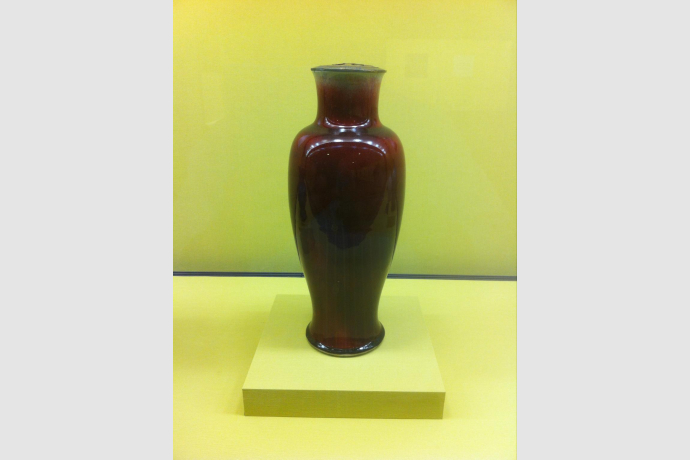River maple trees Conceal the Morning Moon, Flowers Bloom in Imperial Red / The Historical Evolution and Noble Characteristics of Chinese High-Temperature Red Glaze Ceramics.
This year is the Year of the Dragon according to the Chinese zodiac. With the beginning of the Spring Festival, the auspicious dragon celebrates the New Year. Many shopping malls have seized this opportunity to promote the theme of dragons. For example, the Kai Tak Shopping Mall has a dragon cultural exhibition, and the newly established Wisdom Research Cultural Association held an exhibition to promote dragon culture in the basement mall of the Mira Shopping Mall this year. As a totem of the Chinese nation, the dragon is an important part of Chinese culture with a long history. With so much hustle and bustle around, the author has no choice but to take a different approach and tell lesser-known stories. In fact, another important cultural symbol of the Lunar New Year (Spring Festival) is the color red. Because red is full of symbolism, representing joy, auspiciousness, abundance, sunshine, and warmth. Today, let me tell you an interesting story about "Chinese Red" on porcelain!
In the five thousand years of our country's history, the culture is extensive and profound. Since the Han Dynasty, Confucianism has been honored, influenced by Confucianism, Chinese people are generally introverted and not fond of ostentation, with gentleness, respect, humility, and frugality as their characteristics. So the red Chinese people like is not the exaggerated and flashy bright red and purple, but the restrained, soft, and warm orange-red. This color, I believe everyone has a deep understanding because the walls of the Forbidden City, Chinese New Year red packets, Spring Festival couplets, wedding celebrations, etc., are all in that color. Therefore, "Chinese Red" represents auspiciousness, good luck, and happiness!
In the late Tang Dynasty/Five Dynasties, the Changsha Tongguan Kiln began to produce porcelain with red patterns, but the products were relatively rough and the patterns were simple, and we don't know much about them in history. However, this is an important beginning because craftsmen attempted to change the appearance of Qingbai porcelain with a single pattern and began to move towards the world of colored porcelain. This is the origin of the Jun Kiln in the Song Dynasty. The Jun Kiln "one color entering the kiln, ten thousand colors coming out of the kiln," with colors changing endlessly. Famous ones include rose red and lilac purple, which have an important position in history. During the Yuan Dynasty, with Jingdezhen as the center, blue and white porcelain dominated the market, while underglaze red also rose. Although the technology was not mature at the time, controlling the kiln temperature was difficult. If the temperature was too high, it would fly red and the color would be grayish-white. If the temperature was too low, it would turn black. It was very rare to produce genuine red. The famous ones include dragon and phoenix patterns, which are very precious. In the Ming Dynasty, the founding emperor's surname was Zhu, which means red, so the court allocated resources to promote it. The Yongle Xuande period was the time when ruby red was truly burned.
During the Xuande period, "bright red is precious," and the three-fish pattern high-footed cup was considered representative. These collectibles are sought after by antique porcelain enthusiasts worldwide. In the late Ming Dynasty, with political turmoil, eunuchs seizing power, corruption, and chaos, peasant uprisings occurred frequently, and the country no longer had enough resources to continue production. It wasn't until the 44th year of Kangxi's reign that Lang Tingji created Lang Red, and red oil porcelain was revived. The best red glaze in the Qing Dynasty was produced during the Yongzheng and Qianlong periods, including Jihong and Hongdou reds. The glaze colors were rich, the shapes were regular, and the technology was extraordinary, which can be said to be the highest achievement in monochrome glazed porcelain, much admired by people!
We all know that celadon has different colors when fired due to the iron content in the body. With one percent iron content, it becomes white, with two to three percent, it becomes green, and over four percent, it turns into black-brown! But the body clay does not contain copper elements. Red glaze uses copper as a coloring agent. Because its melting point is relatively low, to fire a pure red color, the overall temperature difference cannot exceed 10 degrees. If the temperature is too high, it is called flying red, and the red color will fade. If the temperature is too low, it will turn black-brown. The chance of truly firing a beautiful red color is very low, hence the saying "out of ten kilns, nine failures," and "if you want to be poor, burn Lang Red." As you can understand, hundreds of years ago, firing techniques were not as advanced as they are now. It relied on the experience and ability of the kiln workers to determine the temperature, without humidity meters or temperature gauges, let alone constant temperature facilities. It is not easy to maintain over 1300 degrees for a long time!
Red glaze refers to porcelain that is entirely red in color, which is underglaze color. Underglaze red (red pattern) is actually similar to the production method of blue and white porcelain, both are underglaze color. First, the pattern is painted with red glaze, then covered with transparent glaze, and fired in the kiln at around 1300 degrees Celsius to restore (cool) with flames. Famous patterns include various flower and plant patterns, but overall, the technology is not as advanced as blue and white porcelain, with extremely low production, so if we can collect one or two treasures, it is really something to be happy about!
During the writing period, the Lunar New Year is almost over, and the article about "Chinese Red" seems to be a bit late. I hope everyone can learn something new and increase their understanding of the special significance of the color red in Chinese culture. The author's purpose has been achieved!
Author
Mr. Robert T Li graduated from the Economics Department of the University of Hong Kong and has served as the Head of Liability Insurance in the Greater China region for an international insurance company. He has a passion for traditional Chinese culture and enjoys collecting art. He is actively involved in promoting awareness of traditional Chinese culture, music, and art among young people. He can be contacted at litaichai@gmail.com.
Uploaded on 2024.3.15



